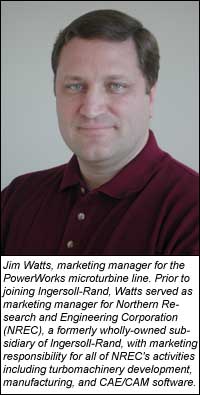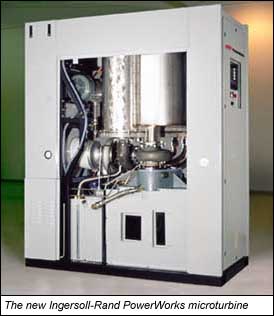Ingersoll-Rand launches new unit, moves microturbine toward market

By April C. Murelio, Managing Editor, Power Online
Giving its microturbine research, development and commercialization effort a higher profile in the organization and more resources, Ingersoll-Rand (Woodcliff Lake, NJ) recently launched a new business unit—Independent Power.
Located on the old Pease U.S. Air Force base in Portsmouth, NH and previously operated as one of Ingersoll-Rand's wholly-owned subsidiaries (Northern Research and Engineering Corporation), Independent Power becomes part of the company's industrial productivity segment starting early next year.
Rone H. Lewis III, a senior vice president with Ingersoll-Rand, was recently appointed to serve as Independent Power's new president. Currently, the new unit employs 70 people and just recently expanded into another facility on the base.
Although its scope may eventually widen, said Jim Watts, marketing manager, Independent Power plans to initially focus on identifying, developing and marketing alternative-power and energy-management solutions. Specifically, he said, that means getting Ingersoll-Rand's new PowerWorks microturbine system to commercial market by the second half of 2001.

"The new business unit is just a few weeks old, so we're still in the planning stages in many respects. However, our goal is very clear," Watts said in an interview with Power Online. "With this new unit, Ingersoll-Rand's microturbine effort has gone company-wide, giving us access to a variety of experienced sales and distribution channels."
Specifically, he said, Independent Power plans to take advantage of Ingersoll-Rand's Air Solutions and Portable Power businesses, its equipment and service centers and the recently acquired Hussmann business, representing more than 125 distribution centers and more than 1,500 technicians to install and service the microturbines.
PowerWorks microturbine to play in the small- to mid-sized markets
According to Watts, Ingersoll-Rand plans to exhibit the latest field test version of the new PowerWorks microturbine system at this year's Power-Gen International in Orlando, Nov. 14-16.
A 70 kW system, PowerWorks not only generates electricity for base consumption or peak shaving, but also produces heat for other applications, including hot water. The system, Watts said, can also integrate with mechanical-drive applications like compressed air, refrigeration and air conditioning equipment.
Although compared with some of its competitors—Toyota Turbine (50 kW and 250 kW), Honeywell (75 kW), and Turbec (100 kW)—the 70 kW PowerWorks microturbine may seem a little small in terms of electricity output.
However, Watts said, the unit's size and versatility clearly define the small- to mid-sized commercial and industrial market that Independent Power hopes to dominate with this first offering. This, by the way, puts Ingersoll-Rand head to head with Capstone, an industry leader that offers a 30 kW system and seems close to moving a 60 kW system to market.
"Our system is designed specifically for the small- to medium-sized business that needs cogeneration," Watts said. "Our sponsors, who have been involved with our research and development effort, helped us define this as an attractive market for us. We may have a smaller unit planned, and eventually, we plan to launch a 250 kW unit, but right now we're not sized or focused on meeting the full energy load."
Those sponsors include Southern California Gas Company, the Gas Technology Institute (formerly the Gas Research Institute-GRI) and the New York Gas Group.
The PowerWorks microturbine's ability to integrate with mechanical-drive applications and provide refrigeration and compressed air, he said, should make it a major player for the supermarket space. According to the Oak Ridge National Laboratory, supermarkets account for about 4% of the total U.S. electricity demand.
And according to Xenergy, a unit of Energy East Corporation, about 3% of the total yearly U.S. electricity consumption relates to compressed air usage, meaning that supermarket refrigeration and air compression equipment represent 7% of the total U.S. power demand.
PowerWorks features, testing results
Currently, Ingersoll-Rand's Independent Power has both alpha and beta units in the field running the testing gauntlet—one unit provides energy and hot water to an ice rink, and other test sites include a multi-family dwelling, a community center and an LNG processing center.

With the exception of "a glitch here and there," Watts said the units are performing well, with confidence running high in the components and no major re-designs anticipated as Independent Power gears up for full commercialization. One site, he said, even performed a test not originally planned but that proved the strength and efficiency of the PowerWorks design.
"We assumed, of course, that the systems sent out for testing will constantly have water running through them," Watts said. "Well, water flow stopped at one customer site while the system kept running. However, the temperature switch did just what it was supposed to do. It shut the system down, with no permanent damage resulting from the dry cycling."
According to Watts, the PowerWorks microturbine features a longer maintenance interval than reciprocating engine-driven generators. For example, Independent Power engineered the system's two-shaft engine to operate 8,000 consecutive hours without maintenance. Under typical around-the-clock operating conditions, Independent Power expects the engine life to be about 80,000 hours or 10 years.
In terms of meeting environmental regulations, the PowerWorks system features a patented low-emission combustor that nets emissions of 9 parts per million or lower, Watts said.
A patented recuperator, which captures energy that would've been lost in the microturbine's exhaust, represents a key component to the PowerWorks system's operating efficiency. According to Watts, Independent Power (then Northern Research and Engineering Corporation) started work on the recuperator in 1994. The company now expects the component to boost efficiency to about 33%, withstand repeated engine cycling and enable the system to reach full power quickly.
Northrop-Grumman also uses the Ingersoll-Rand/Independent Power recuperator in its WR21 engine program, an advanced 20 MW ship propulsion system designed and manufactured for the U.S. and British navies.
"Derived from military applications where performance requirements are very challenging, the IR recuperator technology is exceptional," said Steven I. Freedman, an energy systems expert and former executive scientist at the Gas Research Institute (now the Gas Technology Institute). "Combining the recuperator with the other design features, Ingersoll-Rand has created a unique microturbine line that offers performance versatility and reliability that extends beyond simply generating electricity."
Independent Power/Ingersoll-Rand to remain active in DG issues
In terms of market potential and technology advances, distributed generation (DG) seems destined to come on strong. Analysts predict up to a US$20 billion to US$30 billion market for distributed generation technologies, including microturbines. But, some barriers remain.
According to Watts, an active member of IEEE's "SCC21 P1457 working group" effort to define national standards for DG, interconnection, permitting and siting remain the most contentious—yet not insurmountable.
For example, IEEE hopes to start voting on its proposed interconnection standard next year. By contrast, Watts said, new standard development usually takes eight to 10 years. The DG interconnection effort is only two years old, but those involved, including Ingersoll-Rand/Independent Power, remain confident the aggressive timeline remains doable.
Siting and permitting issues also abound. For example, Watts said, a PowerWorks test unit installation halted briefly because of some unexpected insurance issues. However, he said, Ingersoll-Rand/Independent Power intend to remain active in solving these issues, even if for now it means solving them one customer site at a time.
"Distributed generation remains an emerging and disruptive technology," Watts said. "There's been a lot of progress on technical and non-technical fronts. As we move forward, we need to ensure that we have the cooperation of all the stakeholders, especially the utility industry."
For more information about Ingersoll-Rand and Independent Power's new PowerWorks microturbine, visit www.irco.com or contact Watts, 603-430-7020, Jim_Watts@irco.com.
